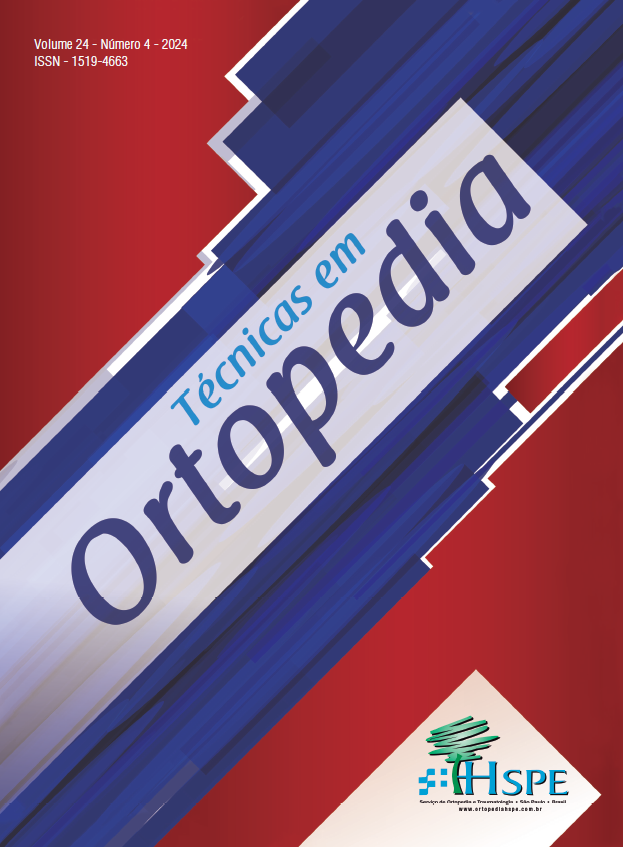REVERSE SHOULDER ARTHROPLASTY IN THE TREATMENT OF POST-TRAUMATIC ELBOW SEQUELAE: CASE REPORT
DOI:
https://doi.org/10.61443/rto.v24i4.472Keywords:
shoulder/surgery; reverse shoulder arthroplasty; proximal humerus nonunion.Abstract
Reverse total shoulder arthroplasty was first developed in 1980 by French surgeon Paul Grammont for patients with cuff tear arthropathy associated with irreparable rotator cuff tears. With advancements in surgical techniques and implant design, additional indications have emerged: complex proximal humerus fractures, nonunion, revision of conventional prostheses, chronic shoulder instability, rheumatoid arthritis or other inflammatory diseases associated with rotator cuff insufficiency, and reconstructions following oncologic resections or failed previous surgeries. However, there is a growing incidence of postoperative complications, reduced durability, and higher revision rates, particularly in younger or high-demand patients.
Current challenges of reverse shoulder arthroplasty include glenosphere loosening, prosthetic instability, limited durability in young patients, deltoid-related complications, restricted range of motion, risk of infections, glenoid or humeral bone loss, technical difficulties in complex cases, and managing patients' expectations regarding functional outcomes. We present a case report of a 55-year-old female patient with sequelae from a left proximal humerus fracture sustained two years prior, treated with reverse shoulder arthroplasty.
Downloads
References
Mata-Fink A, Meinke M, Jones C, Kim B, Bell JE. Reverse shoulder arthroplasty for treatment of proximal humeral fractures in older adults: a systematic review. J Shoulder Elbow Surg. 2013;22(12):1737-48
Barnett JS, Dopirak RM, Brej BL, Katayama ES, Patel AV, Cvetanovich GL, et al. Uncemented versus cemented humeral fixation during reverse total shoulder arthroplasty for proximal humerus fracture. J Orthop. 2024 Oct 29;63:58-63.
Nian PP, Pujari A, Duey AH, Palosaari AA, Levy KH, Bernstein J, et al. Reverse shoulder arthroplasty with isolated latissimusdorsi transfer/additional teres-major transfer for combined loss of elevation and external rotation: A systematic review and metaanalysis. J Orthop. 2024;63:48-57.
Hones KM, Gutowski CT, Rakauskas TR, Bindi VE, Simcox T, Wright JO, et al. Outcomes of lateralized reverse total shoulder arthroplasty versus latissimus dorsi transfer for external rotation deficit: a systematic review and meta-analysis. Clin Shoulder Elb. 2024;27(4):464-478.
Le K, Lilley T, Swanson D, Jawa A. Erosive bilateral glenohumeral osteoarthritis caused by urosepsis-induced septic arthritis. JAAPA. 2024;37(12):25-28.
Brune D, George SZ, Edwards RR, Moroder P, Scheibel M, Lazaridou A. Which patient level factors predict persistent pain after reverse total shoulder arthroplasty? J Orthop Surg Res. 2024;19(1):786.
Hesseling B, Prinsze N, Jamaludin F, Perry SIB, Eygendaal D, Mathijssen NMC, et al. Patient-related prognostic factors for function and pain after shoulder arthroplasty: a systematic review. Syst Rev. 2024;13(1):286.
White AE, Ponce RB, Wrenn SP, Healy RJ, Khanna A, Brusalis CM, et al. Reverse Shoulder Arthroplasty in the Setting of Massive Proximal Humeral Bone Loss: A Systematic Review. J Shoulder Elbow Surg. 2024:S1058-2746(24)00845-0.
Rotman D, Avraham O, Goldstein Y, Kazum E, Rojas Lievano J, Chechik O, et al. Greater Tuberosity Healing Rate and Clinical Results Following RSA Are Similar for Two Fracture-Specific Implant Systems. J Clin Med. 2024;13(22):6967.
Doursounian L, Le Sant A, Mauprivez R, Miquel A, Beauthier-Landauer V. Open reduction and internal fixation of three- and four-part proximal humeral fractures by intra-focal distraction: observational study of twenty five cases. Int Orthop. 2016;40(11):2373-82.
Prat S, Gallardo-Villares S, Vives M, Carreño A, Caminal M, Oliver-Vila I, et al. Clinical translation of a mesenchymal stromal cell-based therapy developed in a large animal model and two case studies of the treatment of atrophic pseudoarthrosis. J Tissue Eng Regen Med. 2018;12(1):e532 e540.
Campochiaro G, Baudi P, Gialdini M, Corradini A, Duca V, Rebuzzi M, et al. Humeral shaft non-union after intramedullary nailing. Musculoskelet Surg. 2017;101(2):189-93.
Barbier D, De Billy B, Gicquel P, Bourelle S, Journeau P. Is the Clavicula Pro Humero Technique of Value for Reconstruction After Resection of the Proximal Humerus in Children? Clin Orthop Relat Res. 2017;475(10):2550-61.
Giardella A, Ascione F, Mocchi M, Berlusconi M, Romano AM, Oliva F, et al. Reverse total shoulder versus angular stable plate treatment for proximal humeral fractures in over 65 years old patients. Muscles Ligaments Tendons J. 2017;7(2):271-8.
Wölfl C, Schuster L, Höner B, Englert S, Klein R, Hirche C,et al. Influence of extracorporeal shock wave therapy (ESWT) on bone turnover markers in organisms with normal and low bone mineral density during fracture healing: a randomized clinical trial. GMS Interdiscip Plast Reconstr Surg DGPW. 2017;6:Doc17.
Ceynowa M, Treder M, Dąbrowski F, Piotrowski M, Pankowski R, Rocławski M. Inferior shoulder dislocation after shortening osteotomy of the humerus. A case report. Trauma Case Rep. 2018;17:9-13.
Geßmann J, Königshausen M, Schildhauer TA, Seybold D. [Periprosthetic humeral fractures: from osteosynthesis to prosthetic replacement]. Oper Orthop Traumatol. 2019;31(2):84-97. German.
Madhuri V, Ramesh S, Varma H, Sivadasan SB, Sahoo B, John A. First Report of a Tissue-Engineered Graft for Proximal Humerus Gap Non-union After Chronic Pyogenic Osteomyelitis in a Child: A Case Report. JBJS Case Connect. 2020;10(1):e0031.
Baldairon F, Antoni M, Le Thai V, Clavert P. Is early mobilization a viable option after intramedullary nailing of 4-parts proximal humerus fractures? Eur J Orthop Surg Traumatol. 2023;33(6):2595-9.
Touloupakis G, Ruberto E, Pernigotti E, Theodorakis E, Gilli A, Messori M, et al. Helical PHILOS plating in shaft humeral fractures with proximal extension: a safe choice using an anterior approach. Clin Ter. 2024;175(5):318-22.





